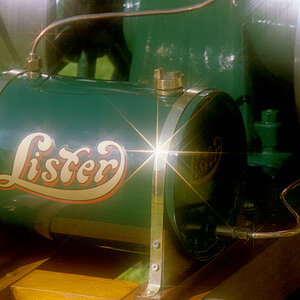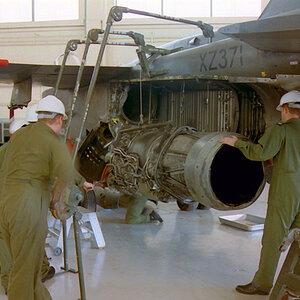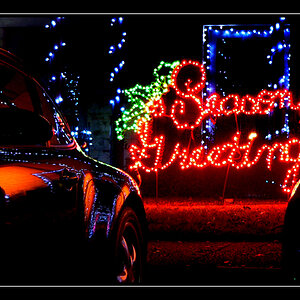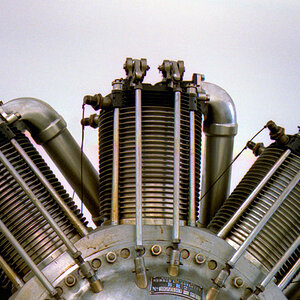- Joined
- May 1, 2008
- Messages
- 25,422
- Reaction score
- 5,003
- Location
- UK - England
- Website
- www.deviantart.com
- Can others edit my Photos
- Photos OK to edit
Ok I've gone and totally confused myself on how macro lenses are working and I'm starting to question (based on someone elses input) on if my loose understanding of how a macro lens works is correct (at least in so far as layman terms) or if I've made a gross mistake that is leading to some confusion.
This is kind of broken into two parts:
PART A
I've been considering purchasing the Tokina 35mm f2.8 macro lens - a true (1:1 magnification) macro lens as a compliment to my other macro lenses (see signature). The main property (macro wise) that I was interested in was the reduced blurring of background elements by this lens over longer telephoto options such as the sigma 150mm f2.8 macro - whilst retaining the same magnification factor in both lenses.
Now as far as I'd be led to understand this was a property of the focal length of the lens and that between a 35mm and a 150mm I would see a change in the background blur (details rendered missing or blurred to monocolour in the 150mm would now be more patchy or distinctive of a rough shape with the 35mm).
However as part of this another member did a test comparing
Tokina 90mm f2.8 macro
against
50mm lens on extension tubes
With both used to take test shots at the same magnification factor. The result however showed that the 90mm was resolving more background detail and shape than the 50mm and extension tubes; dispite the latter setup having a shorter focal length. Both were used on a canon body and set to the same noted aperture on the camera body itself
So first part of the question - what/is there something going on with the extension tube setup against the macro lens that is confusing the issue?
PART B
My own understanding and explanation to the above was/is that the macro lens is reducing its aperture to f5.6 already (a change not reported to the user on Canon camera bodies) and thus when compared against the extension tube setup (which as per part A might also be doing something to the actual aperture) the apertures were not, in fact, both the same but were different.
However this was countered by another member who stated that the working internals of a macro lens shifted the lens assembly forward internally to increase the size of the reflected image on the sensor (thus giving the magnified macro image result). This thus gives us the light transmission loss (darkening viewfinder) that we see when focusing to 1:1 on macro lenses - but importantly did not affect the actual aperture of the resulting lens. Ie it was still f2.8.
Now in my experience this is confusing as I've always be told before that the aperture itself was reducing and that this can be verified by the Nikon camera bodies which report to the user an aperture of around f5.6 when at 1:1 rather than f2.8 - reflecting the loss of light and the change in the actual aperture of the lens when using macro lenses (this is not just a canon/nikon build difference - this is a change shown with lenses such as the sigma 150mm when used on both bodies).
Now clearly one camera group is twisting the truth
Either the lens aperture is not changing (thus canon are correct) and nikon are changing the aperture report to fit with the light loss only and not also the depth of field (as one would expect from a change in aperture)
or
the lens aperture is changing and nikon are telling the "truth" to the user whilst canon are only saying that the lens darkens (light transmittance reduces over the capture frame area) and not informing the user of the actual aperture change
Or there is a scary third option that some lenses are operating by the first proposed method and others by the second proposed method. (for example the canon MPE is listed in the manual as stopping down its aperture as it increases its magnification - of course this lens is a bit beside itself compared to the others so might be operating by a totally different method).
So there we have it - I'm left all confused and not quite sure what is going on. Dose anyone have any good references/experience or answers to the above?
(ps I'm pretty sure I asked a similar question before though I can't find it now so I might just be going over ground that I've forgotten/become unsure of through time).
This is kind of broken into two parts:
PART A
I've been considering purchasing the Tokina 35mm f2.8 macro lens - a true (1:1 magnification) macro lens as a compliment to my other macro lenses (see signature). The main property (macro wise) that I was interested in was the reduced blurring of background elements by this lens over longer telephoto options such as the sigma 150mm f2.8 macro - whilst retaining the same magnification factor in both lenses.
Now as far as I'd be led to understand this was a property of the focal length of the lens and that between a 35mm and a 150mm I would see a change in the background blur (details rendered missing or blurred to monocolour in the 150mm would now be more patchy or distinctive of a rough shape with the 35mm).
However as part of this another member did a test comparing
Tokina 90mm f2.8 macro
against
50mm lens on extension tubes
With both used to take test shots at the same magnification factor. The result however showed that the 90mm was resolving more background detail and shape than the 50mm and extension tubes; dispite the latter setup having a shorter focal length. Both were used on a canon body and set to the same noted aperture on the camera body itself
So first part of the question - what/is there something going on with the extension tube setup against the macro lens that is confusing the issue?
PART B
My own understanding and explanation to the above was/is that the macro lens is reducing its aperture to f5.6 already (a change not reported to the user on Canon camera bodies) and thus when compared against the extension tube setup (which as per part A might also be doing something to the actual aperture) the apertures were not, in fact, both the same but were different.
However this was countered by another member who stated that the working internals of a macro lens shifted the lens assembly forward internally to increase the size of the reflected image on the sensor (thus giving the magnified macro image result). This thus gives us the light transmission loss (darkening viewfinder) that we see when focusing to 1:1 on macro lenses - but importantly did not affect the actual aperture of the resulting lens. Ie it was still f2.8.
Now in my experience this is confusing as I've always be told before that the aperture itself was reducing and that this can be verified by the Nikon camera bodies which report to the user an aperture of around f5.6 when at 1:1 rather than f2.8 - reflecting the loss of light and the change in the actual aperture of the lens when using macro lenses (this is not just a canon/nikon build difference - this is a change shown with lenses such as the sigma 150mm when used on both bodies).
Now clearly one camera group is twisting the truth
Either the lens aperture is not changing (thus canon are correct) and nikon are changing the aperture report to fit with the light loss only and not also the depth of field (as one would expect from a change in aperture)
or
the lens aperture is changing and nikon are telling the "truth" to the user whilst canon are only saying that the lens darkens (light transmittance reduces over the capture frame area) and not informing the user of the actual aperture change
Or there is a scary third option that some lenses are operating by the first proposed method and others by the second proposed method. (for example the canon MPE is listed in the manual as stopping down its aperture as it increases its magnification - of course this lens is a bit beside itself compared to the others so might be operating by a totally different method).
So there we have it - I'm left all confused and not quite sure what is going on. Dose anyone have any good references/experience or answers to the above?
(ps I'm pretty sure I asked a similar question before though I can't find it now so I might just be going over ground that I've forgotten/become unsure of through time).


![[No title]](/data/xfmg/thumbnail/32/32701-51bacbc6ea9d40683123c14f053d4742.jpg?1619735603)



![[No title]](/data/xfmg/thumbnail/37/37613-6b200847731e552bb4bf9ba3bdb80183.jpg?1619738150)
![[No title]](/data/xfmg/thumbnail/33/33343-857a08c1327857172779bfe49f06f638.jpg?1619735911)





